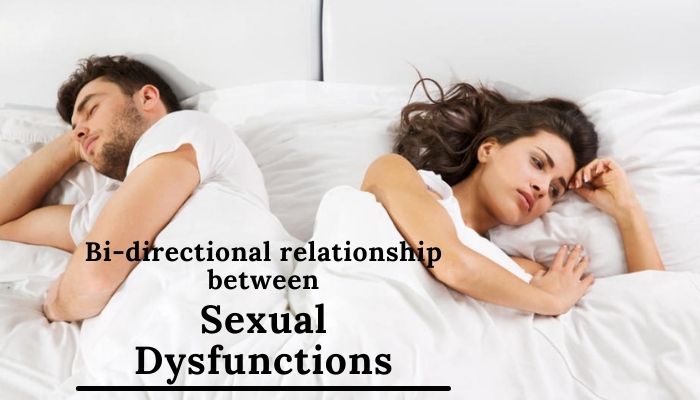Defining Sexual Dysfunctions
Sexual dysfunctions (SD) are a heterogenous group of disorders that are characterized by significant disturbance in a person’s ability to respond sexually or to experience sexual pleasure. An individual may have several SDs at the same time.

According to DSM-5 (Diagnostic and Statistical Manual of Mental Disorders, fifth edition), SDs include delayed ejaculation, erectile dysfunction, female orgasmic disorder, female sexual arousal disorder, genito-pelvic pain/penetration disorder, male hypoactive sexual desire disorder and premature ejaculation. SD can also result due to substance use and side effects of certain medications. Other medical conditions can also result in SDs.
The normal human sexual response cycle consists of four phases;
- Desire phase which consists of fantasies and desire to have sexual activity
- Excitement phase which consists of the subjective sense of sexual pleasure along with the physiological changes like penile erection and vaginal lubrication.
- Orgasm phase marks the peak of sexual excitement with release of sexual tension. In men, the urge to ejaculate followed by ejaculation and in women, rhythmic contractions of cervix and vagina.
- Resolution phase brings a sense of muscular relaxation and general well-being. Men are not ready for another erection for some time. However, women may be able to respond to stimulation immediately.
Sexual Dysfunction is a persistent, distressing change in any of these stages, thus an individual can have several SDs at a time, and all of them need to be evaluated and treated.
Defining Depression
Depression is a major mental illness characterized by pervasive sad mood, loss of interest in almost all activities along with changes in appetite or weight, sleep and activity levels, fatigue and difficulty in concentration. Depressed individuals may have negative thoughts about themselves and the world around them with pessimistic thinking, feelings of worthlessness, hopelessness, helplessness, occasional or continuous thoughts about suicide. These symptoms must be clearly a worsened state compared to pre-morbid functioning and the symptoms should be present for more than two weeks continuously and should lead to significant dysfunction in all aspects of life, to make a diagnosis of Major Depressive Disorder
The complex Bi-directional relationship between Sexual Dysfunction and Depression
There exists a complex bi-directional relationship between Sexual Dysfunction and Depression. Depression is associated with a 50-60% increased risk of sexual dysfunction, while SD can raise the risk of depression by 130-200% (according to a study done in India). According to Avasthi et al; 2017, a review article published in Indian Journal of Psychiatry, prevalence of SD in general population is very high, 43% in women and 31% in men. Research across the globe suggests that roughly 60% of depressed individuals report of SD. It is understandable that depression, characterized by loss of interest in all activities encompasses a loss of interest in sexual activity. Loss of libido is also one of the “VITAL” symptoms of depression which is an indicator that the depression is severe. It has been well established that regardless of medication, improvement in depression can improve the overall quality of life and thus improve the sexual functioning too. This bidirectional relationship is further compounded by antidepressant induced sexual dysfunction or Treatment Emergent Sexual Dysfunction (TESD). On the one hand, antidepressants can improve the mood thus improving the quality of life but on the other hand, they can worsen existing dysfunction and can also be responsible for new onset SDs.
This confounding relationship between SD and Depression often leads to under reporting, poor assessment and management. It is easily overlooked by the treating psychiatrist which is also contributed by general lack of awareness and stigma prevalent among population.
Sexual Dysfunction among women
Sexual dysfunction among women is often less talked about and not given much importance to, due to stigma, embarrassment and the notion that it is unworthy of treatment. There exists a taboo in India to speak about a woman’s sexuality, let alone seeking treatment for sexual problems. Nevertheless, female sexual dysfunction is a common problem with significant impact on well-being. SD among women usually arise in the desire and arousal stages of sexual cycle. Most common SD among women is Hypoactive Sexual Desire Disorder.
Evaluation should include investigations to assess general physiological health conditions and to identify disorders such as diabetes, hypertension, hypo or hyperthyroidism, menopause, genito-urinary tract infections and any neurological conditions preventing the woman from engaging in sexual activity successfully. This should be followed by a detailed assessment for identifying psychological well-being and stressors. Psychological problems like past history of sexual abuse or trauma, body image issues, low self-esteem, performance anxiety and uncertainty in a relationship can interfere with sexual functioning. In a woman who is already suffering from depression, presence of such psychological risk factors increases the complexity of the problem and warrants detailed analysis and treatment.
While treating depression with antidepressants, it is important to explain the side effects beforehand to avoid any confusion or worries on development of TESD. Often validation of woman’s concerns and suggesting alternative medication with lesser side effects is all that is needed to alleviate anxiety and improve sexual functioning.
Treatment of SD in women with Depression can be either pharmacological or psychological. Psychological treatments are better as there are no side effects and they adapt a broader approach and aim at general psychological well-being and not just amelioration of sexual dysfunction.
- Sex therapy: sex therapy consists of improving couple’s erotic experiences and diminishing anxiety and self-consciousness via “SENSATE FOCUSING”, which is the cornerstone of sex therapy. Sensate Focusing is a technique wherein the couple is trained to focus on sensations rather than on the quality of performance. It helps to address women’s poor self-image and internalization of negative messages about female sexuality as well as addresses anorgasmia due to performance anxiety.
- Cognitive behavior therapy: CBT includes components of sex therapy but emphasizes more on modifying thoughts and beliefs that interfere with sexual pleasure, thus alleviating anxiety. Working on dysfunctional thoughts in addition to behavioral strategies like relaxation, spending quality time with partner and improving the intimacy in relationship rather than focusing on sexual performance can definitely improve overall quality of life.
- Mindfulness: mindfulness emphasizes on being present in the moment and being aware of the thoughts, however not going into the analysis of the thoughts. This method helps women who have past history of trauma.
Any therapy reaps higher benefits if both partners are honest and completely involved from the beginning of therapy.
Pharmacological agents which improve desire in women should be given only by a qualified psychiatrist or sexologist, after evaluating physiological and psychological factors leading to SD and after successful treatment of Depression itself.
Sexual dysfunction among Men
Most common SD among men are Premature ejaculation and Erectile Dysfunction. Among men suffering from depression and TESD, problems with desire and ejaculation are the most frequent. Lack of knowledge about normal sexual functioning due to lack of proper sex education, fear of embarrassment and dearth of reliable resources are the major barriers for evaluation and treatment of SD among men.
Just like in women, men can have SD secondary to medications like antihypertensives, anti-diabetic medicines, opioids, narcotic drugs and alcohol. Thorough evaluation of physiological problems will help diagnose depression induced SD and TESD. Many anti-depressants can lead to diminished libido and delayed ejaculation and therefore a thorough education before starting treatment is essential.
Erectile dysfunction is often under-reported due to cultural beliefs and stigma. Psychogenic factors and performance anxiety are the most important reasons for erectile dysfunction. Stress and anxiety related to performance further reduces the quality of performance via stress related hormonal imbalance, medicated by complex neural pathways. Thus, Erectile dysfunction can have vascular, hormonal, neural and psychogenic causes with Diabetes playing a very important role. Sometimes cardiovascular involvement in poor sexual functioning may be an early indication of slow cardiac failure. Other disorders like Parkinson’s disease, epilepsy, multiple sclerosis, brain or spinal cord injury can also affect sexual functioning in various ways.
First line pharmacological agents are phosphodiesterase-5 inhibitors ex. Sildenafil, famously called Viagra, which can improve erection. These agents should be prescribed by qualified medical practitioner after thorough evaluation and treatment of Depression. Medicines can treat only vascular and hormonal causes of erectile dysfunction. Psychological component is addressed by CBT. Psychotherapy and Medicines act synergistically to improve sexual functioning.
Focusing on relationship
For both men and women, apart from specific treatment for SD, life style modifications like balanced diet, regular exercise, healthy habits and relaxation can improve general well-being. Another important area to work on is the “romantic” aspect of the relationship which tends to fade over time as new roles and responsibilities take up the forefront of one’s life. A good approach to address this is a “life span approach” wherein a time line of the couple’s relationship is presented to them emphasizing the difference between early stages of relationship when the romance was alive to the present state of relationship. The couple is advised to spend quality time with each other and to improve the communication between them. Often sexual pleasure is directly proportional to the quality of overall relationship. Personal differences on topics like gender roles and gender-equality, financial goals, personal goals can lead to dissatisfaction and either of the couple may experience depression. Depression further reduces sexual functioning and thus it becomes a vicious cycle. If not identified and treated appropriately, often it ends in separation or divorce.
Conclusion
Sex has an evolutionary role and is the most important bonding factor in any relationship. Thus, it is a good idea to discuss about each person’s sexual expectations before entering marriage and for this to happen, we need a change from the grass root level in terms of providing proper sex education to adolescents and adults in an age-appropriate manner. Open communication between children and parents, not reprimanding when children naturally develop interest in sexual matters and allowing them to talk freely and giving them correct information can prevent children and adolescents from seeking the same information through media which is often misleading. Thus, a strong foundation needs to be laid in childhood itself to bring up a generation of healthy and sexually well-functioning adults.
If you want to get called back from our experts, Leave your details below-


Leave a Reply